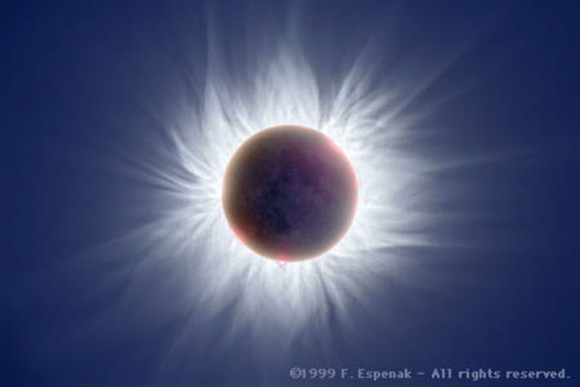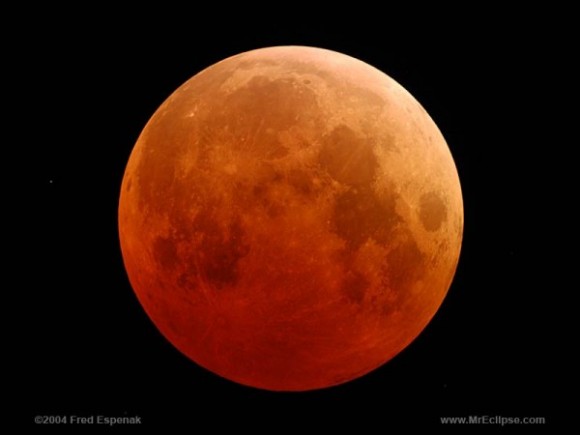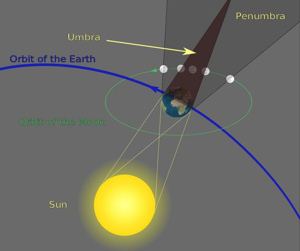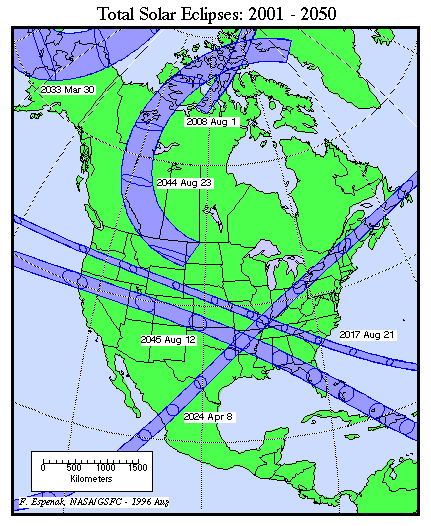
Eclipses of the sun and moon excite more interest than any other event in astronomy. And no wonder. It’s a thrill to go outdoors, witness these grand spectacles of nature, and stand in line with the sun, Earth and moon. How rare are these events? Follow the links below to learn more about lunar and solar eclipses.
How many solar or lunar eclipses occur in one calendar year?
Is it possible to have three eclipses in one month?
Some cool things about years with seven eclipses.
Is it possible to have eight eclipses in one year?
Dates of lunar and solar eclipses in 2017
Great American total eclipse of sun: August 21, 2017
Order your safe solar eclipse glasses from EarthSky



How many solar or lunar eclipses occur in one calendar year? The answer very much depends on the year. One calendar year has a minimum of four eclipses – two solar eclipses and two lunar eclipses. Most years – such as 2017 – have only four eclipses, although you can have years with five eclipses (2013, 2018 and 2019), six eclipses (2011 and 2020) or even as many as seven eclipses (1982 and 2038).
It is rare to have seven eclipses in one calendar year, however. The last time was 1982 and the next time will be 2038. Any calendar year presenting the maximum seven eclipses must have the first eclipse coming in early January, in order to leave enough room for the seventh eclipse to take place in late December. Then the middle part of the year has to stage three eclipses within the framework a single lunar month – the period of time between successive new moons or full moons. The lunar (or synodic) month has a mean duration of 29.53059 days.
Why don’t we see them all? If there are so many eclipses in a single year, why don’t we see more eclipses? In fact, when an eclipse occurs in your area, it’s a fairly rare event! To see a total solar, you have to be located along a narrow path on Earth’s surface, the path taken by the moon’s shadow as it sweeps across Earth. At such times, those outside the shadow path – but still near it – can see a partial solar eclipse.
However, whenever two solar eclipses occur in one lunar month, there are never two total solar eclipses in a single lunar month. Both are very shallow partial solar eclipses. Moreover, one of these solar eclipses takes place in the Arctic region of the globe while the other happens in the Antarctic. In other words, very few people are in a position to witness either one of the two shallow solar eclipses that occur in one lunar month.
Although total lunar eclipses are more encompassing than total solar eclipses, visible to everyone on Earth’s night hemisphere as the total lunar eclipse is taking place, the two lunar eclipses taking place in one lunar month are never total. In fact, it’s highly unlikely that one of the two is even a partial lunar eclipse. Whenever two lunar eclipses happen in one lunar month, both of them are most often faint penumbral lunar eclipses that are either impossible or hard to see.
Is it possible to have three eclipses in one month? It’s quite rare to have three eclipses in one calendar month. The last time it happened was in the year 2000, and the next time won’t be until the year 2206!
It’s more common to have three eclipses within one lunar month. A lunar month refers to time period between successive new moons, or successive full moons. The last time three eclipses happened in a lunar month was in the year 2013. The next time will be 2018.
Three eclipses in a month can be either two solar eclipses and one lunar eclipse, or two lunar eclipses and one solar eclipse. If the first of three eclipses is a solar eclipse, then the third eclipse will be solar and the middle one lunar. If, on the other hand, the first eclipse is lunar, the third will be lunar and the middle one solar. That’s because a solar eclipse happens within one fortnight (two weeks) of a lunar eclipse – and vice versa.
Read more: Three eclipses in one month
Some cool things about years with seven eclipses. Notice the two-week separations accompanying the eclipse pairs and eclipse triplets in the lists below. We list the seven eclipses for the years 1982 (4 solar/3 lunar) and 2038 (3 solar/4 lunar):
| 1982 (Seven eclipses: 4 solar/3 lunar) | 2038 (Seven eclipses: 3 solar/4 lunar) |
| Jan 9 lunar eclipse | Jan 5 solar eclipse |
| Jan 25 solar eclipse | Jan 21 lunar eclipse |
| Jun 21 solar eclipse | Jun 17 lunar eclipse |
| Jul 6 lunar eclipse | Jul 2 solar eclipse |
| Jul 20 solar eclipse | Jul 16 lunar eclipse |
| Dec 15 solar eclipse | Dec 11 lunar eclipse |
| Dec 30 lunar eclipse | Dec 26 solar eclipse |
A year containing seven eclipses can harbor a maximum of five solar or five lunar eclipses. In this scenario, two lunar months contain three eclipses each (for a total of six eclipses), and a single eclipse happens in late December or early January.
| 1935 (Seven eclipses: 5 solar/2 lunar) | 2132 (Seven eclipses: 2 solar/5 lunar) |
| Jan 5 solar eclipse | Jan 2 lunar eclipse |
| Jan 19 lunar eclipse | |
| Feb 3 solar eclipse | May 30 lunar eclipse |
| Jun 13 solar eclipse | |
| Jun 30 solar eclipse | Jun 28 lunar eclipse |
| Jul 16 lunar eclipse | |
| Jul 30 solar eclipse | Nov 23 lunar eclipse |
| Dec 7 solar eclipse | |
| Dec 25 solar eclipse | Dec 22 lunar eclipse |
Seven eclipses occur in a minimum of 12 lunar months (about 354.37 days). Given that the calendar year is only about eleven days longer than 12 lunar months, the first of the seven eclipses has to come in early January for the seventh eclipse to occur before the end of the year.
A solar eclipse always happens within one fortnight (two weeks) of a lunar eclipse – or vice versa. Yet it’s still possible that eclipses separated by a fortnight can occur in different calendar years. For instance, the solar eclipse at the end of the year on December 25, 1935, was followed by a lunar eclipse one fortnight (two weeks) later on January 8, 1936. In another example, the lunar eclipse at the beginning of the year on January 2, 2132, will come one fortnight after the solar eclipse of December 19, 2131.
Can there be eight eclipses in a calendar year? No. Eight eclipses occur in a minimal period of 12.5 lunar months (about 369 days), making it impossible for eight eclipses to fit within the framework of a calendar year (365 or 366 days).

Bottom line: Any calendar year has a minimum of four eclipses – two solar and two lunar. Most years have only four eclipses, but depending on the year, it’s possible to have five eclipses, six eclipses or even as many as seven eclipses in one year’s time.











